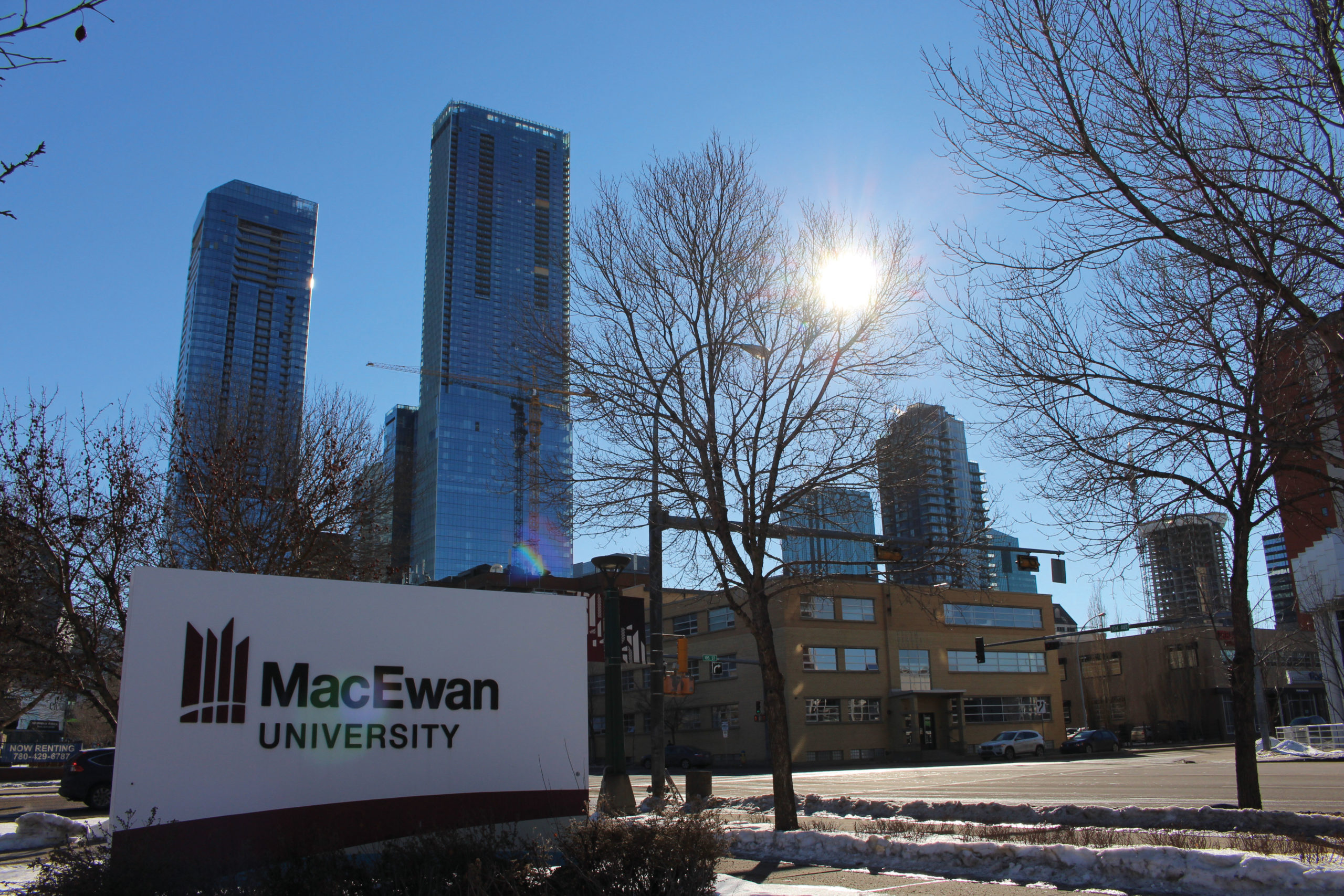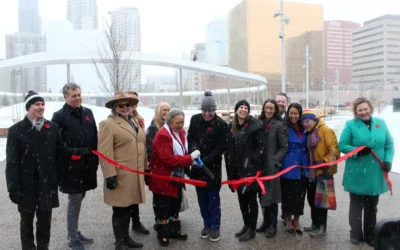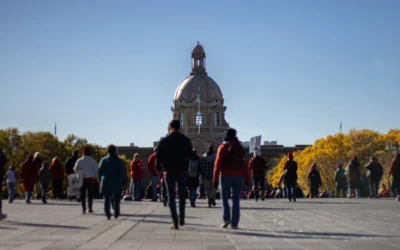It’s easy to see the changes to Edmonton’s downtown skyline over the last few years. Cranes have been a constant while the new Stantec Tower and JW Marriott hotel and residences were constructed, topping off at 66 and 56 floors, respectively. The Walterdale Bridge Replacement, which opened to traffic in 2017, has also added a different trademark to the cityscape when looking from the North Saskatchewan’s river bank.
There’s also been changes at street level in recent years, particularly at MacEwan University’s City Centre Campus. The construction and opening of Allard Hall in 2017 extended the University’s footprint further into the community of Oliver, linking the mature community even more so with downtown. The building’s striking colour scheme and height also add more depth and character to 104 Street.
Along with all those tall towers and new buildings, Boyle Street Community Services, Hope Mission, and the Herb Jamieson shelter are all within a stone’s throw of MacEwan’s campus and serve some of Edmonton’s marginalized populations of the homeless and those with substance abuse issues. Four supervised injection sites operate within relative proximity to the university, a necessity in a city that saw over 130 overdose deaths due to fentanyl and over 20 caused by carfentanil in 2018, according to a report on the Government of Alberta website.
Speaking with the griff in early January, Myrna Khan, MacEwan’s first vice president of University Relations, said that it’s important to recognize the university’s connection with both the shiny new towers and the not-so-shiny areas to the north.

“I think the uniqueness of being here in the urban centre affords our students a lot of opportunities that we may not see in other institutions,” she said.
“We like to talk about MacEwan being a bridge, not a wall; a bridge between the business community to the south and some of the more challenged and distressed communities to the north. So by being a bridge and bringing those two together, we can start to really expose our students to what both sides look like, but also start to solve and peel away at some of those bigger social issues.”
Khan points to graduates of the University’s Nursing, Social Work, and Policing Studies programs as examples of being on the ground and actively working with people dealing with addiction and homelessness.
“I think it’s really an advantage of the fact that we’re actually here and located in the urban centre,” says Khan.
As the first person to hold the position of VP Community Relations, Khan said that her job is to evaluate MacEwan’s current relationships with community partners, and assess how they can be further cultivated.
“Part of my role going forward is to understand what those relationships are, understand what the connections are to MacEwan, and really invest and foster those relationships because we can’t succeed unless our community succeeds around us.”
Beyond MacEwan’s relationship with vulnerable populations in the community, the University is also further developing connections with businesses and organizations located in the city’s core.
One of those relationships is with the Downtown Business Association (DBA), headed by executive director Ian O’Donnell. The DBA’s main focus is to improve the look and feel of Edmonton’s downtown centre, attracting more people and businesses through initiatives such as the Facade Improvement Program, which helps businesses revamp the curb appeal of their location, as well as events that get people into the core, like Downtown Dining Week this past March.

O’Donnell told the griff that he believes MacEwan’s expansion and further development has only helped with the revitalization and improvement of Edmonton’s downtown. The University was opened on the former CN rail yard in 1995 when Edmonton’s economy was in a rough patch and community organizers were thinking about solutions to the exodus of people and businesses.
“It was very good timing I think; MacEwan (opened downtown) in 1995, so very much in line with the downtown plan to convert the old rail yards along with Railtown (in Oliver) into a place for people, a place for learning and a place for living. Certainly over the last 20-25 years, we’re seeing great expansion of MacEwan and of the residential population,” he said.
“It’s a had a huge trickle down impact, so students and staff (are) living in the downtown, choosing to walk to school or to work, a lot of people have oriented their businesses to be taking advantage of the daytime population. It’s really just made downtown feel more complete with their expansions of what used to be essentially dirt lots or old rail lots.”
MacEwan opened their doors to the DBA in November of last year, in order to facilitate a roundtable discussion with various community partners about the safety and security of downtown, the topic of their 2019 report. Sixty people discussed nine topics that have affected the downtown area, including homelessness, panhandling, mental health, addiction and drug use, theft, and harassment.
“I think it’s really a vantage of the fact that we’re actually here and located in the urban centre.”
— Myrna Khan, VP University Relations MacEwan
The report found that people in the downtown feel “as if challenges linked to people experiencing homelessness are intensifying across Edmonton.” Respondents during the roundtable event discussed that while major perceptions surrounding homeless in the area are not realities, “understanding homelessness and its causes are big challenges” to the community.
Respondents also commented on the fact that education and awareness of the social situations that cause and perpetuate homelessness and drug addiction needs to go farther, including with people who may only work downtown, not live in the area, noting that “there are a lack of resources to address root causes.”
“They said education for business owners and security guards on responding to addictions issues is sorely needed, and that finding the balance between safety and social responsibility is hard. Respondents said the biggest perceived issue is mental health, and this sees limited resources devoted to support people. Respondents also noted a lack of resources for non-emergency services, naloxone kits and training are all challenges,” the report reads.
While outlining the challenges to safety and security in the core, the report also provides a list of broad ways community members can move forward. These include working with what community members already have, such as schools and social organizations, recognizing that harrassment comes from not only marginalized groups but also from more affluent people attending events such as Oilers games, and further education about the root causes of homelessness, addiction, and crime.
Last summer, MacEwan’s Board of Directors approved the University’s new 25-year campus master plan, a document outlining the precise development trajectory MacEwan wants to follow. It includes plans for new buildings, improved environmental impact, and increased walkability, as well as development of different academic programs in the future.
MacEwan President Dr. Deborah Saucier wrote in her opening letter in the plan that the plan is centred around the university’s unique position as Edmonton’s downtown campus.
“The Campus Master Plan will help us define how we interact with — and form a bridge between — the high-rises, businesses and condominiums in the city’s downtown core, and the neighbourhoods that are home to some of our most vulnerable citizens and the services on which they rely,” she wrote.
As MacEwan commits further to the 25-year master plan, and as Edmonton’s downtown continues to revitalize, it will be interesting to see what kind of change occurs from these two groups that can mitigate, if not solve some of the issues surrounding those at their most vulnerable in the community.
Photography supplied and by Devyn Ens.





0 Comments